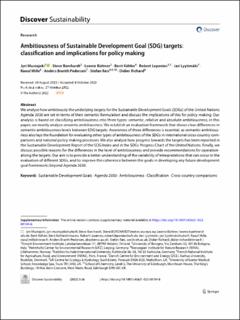Ambitiousness of Sustainable Development Goal (SDG) targets: classification and implications for policy making
Mustajoki, Jyri; Borchardt, Steve; Büttner, Leonie; Köhler, Berit; Lepenies, Robert; Lyytimäki, Jari; Mille, Raoul; Pedersen, Anders Branth; Reis, Stefan; Richard, Didier
Peer reviewed, Journal article
Published version

Åpne
Permanent lenke
https://hdl.handle.net/11250/3033472Utgivelsesdato
2022Metadata
Vis full innførselSamlinger
- Publikasjoner fra CRIStin - NINA [2364]
- Scientific publications [1392]
Originalversjon
10.1007/s43621-022-00104-8Sammendrag
We analyse how ambitiously the underlying targets for the Sustainable Development Goals (SDGs) of the United Nations Agenda 2030 are set in terms of their semantic formulation and discuss the implications of this for policy making. Our analysis is based on classifying ambitiousness into three types: semantic, relative and absolute ambitiousness; in this paper, we mainly analyse semantic ambitiousness. We establish an evaluation framework that shows clear differences in semantic ambitiousness levels between SDG targets. Awareness of these differences is essential, as semantic ambitiousness also lays the foundation for evaluating other types of ambitiousness of the SDGs in international cross-country comparisons and national policy making processes. We also analyse how progress towards the targets has been reported in the Sustainable Development Report of the SDG Index and in the SDGs Progress Chart of the United Nations. Finally, we discuss possible reasons for the differences in the level of ambitiousness and provide recommendations for operationalising the targets. Our aim is to provide a better understanding of the variability of interpretations that can occur in the evaluation of different SDGs, and to improve the coherence between the goals in developing any future development goal frameworks beyond Agenda 2030. Ambitiousness · Classification · Cross-country comparisons
